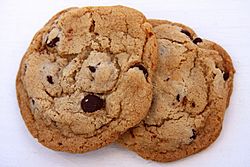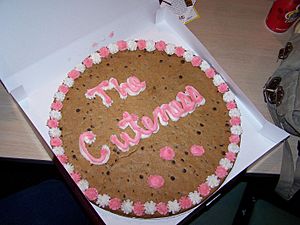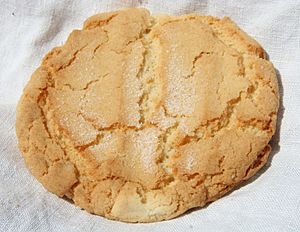Cookie facts for kids

Chocolate chip cookies
|
|
| Alternative names | Biscuit |
|---|---|
| Course | Snack, dessert |
| Place of origin | Persia, 7th century AD |
| Serving temperature | Often room temperature, although they may be served when still warm from the oven |
A cookie is a small, flat, and sweet treat that is usually baked. It's often made with flour, sugar, and some kind of oil or fat. You might find other yummy things in them like raisins, oats, chocolate chips, or nuts.
In many parts of the world, like the UK, crisp cookies are called biscuits. But even there, chewier ones are sometimes called cookies. Some cookies get their names from their shape, like 'bars' or 'squares'.
Cookies can be made in big factories, small bakeries, or right at home! There are many types, like sandwich cookies (think Oreos!) that have a sweet filling, sometimes dipped in chocolate. People often enjoy cookies with milk, coffee, or tea. You can buy them in grocery stores, convenience stores, and even vending machines. Fresh-baked cookies are sold at bakeries and coffeehouses like Starbucks.
Contents
What are Cookies Like?

Most cookies are flat and round. They often have extra flavors added, such as spices, chocolate, butter, peanut butter, nuts, or dried fruits. Most cookies are very sweet!
Cookies are usually baked until they are crisp or just soft. But some types of cookies don't need baking at all. The softness of a cookie can depend on how long it's baked.
Unlike cakes, which use water to make the batter thin and bubbly, cookies use oil or fat to hold them together. Oils, like butter or vegetable oils, are thicker than water. They also stay in the cookie after baking, making it wonderfully crisp and moist with oil.
How Did Cookies Start?
Hard, thin wafers have been made for a very long time. They were popular because they lasted a long time and weren't easily broken. However, they weren't usually sweet enough to be called cookies today.
The first cookies were made in Persia (which is now Iran) in the 7th century AD. This was soon after sugar became widely used there. Cookies then traveled to Europe when the Muslims conquered Spain. By the 14th century, cookies were popular all over Europe. You could find them everywhere, from royal kitchens to street vendors.
As people started traveling more around the world, cookies became a great snack for journeys. They were a sweeter version of the travel cakes that had been used throughout history. One of the earliest and most popular cookies for travel was the jumble. It was a hard cookie made mostly from nuts, sweetener, and water. Jumbles became known on every continent.
Types of Cookies
Cookies are usually grouped by how they are made. Here are some main types:
- Bar cookies are made by pouring dough into a pan. After baking, they are cut into cookie-sized pieces. Brownies and date squares are examples.
- Drop cookies are made from soft dough that is dropped by spoonfuls onto a baking sheet. As they bake, the dough spreads out. Chocolate chip cookies and oatmeal cookies are popular drop cookies.
- Filled cookies have a fruit or sweet filling inside. The dough is rolled out, filled, and then baked.
- Molded cookies are made from a stiffer dough that is shaped by hand into balls or other forms before baking. Snickerdoodles and peanut butter cookies are examples.
- No-bake cookies don't need an oven! They are made by mixing ingredients like cereal or nuts with a melted sweet binder. Then they are shaped and allowed to cool and harden. Rum balls are a type of no-bake cookie.
- Pressed cookies use a special tool called a cookie press. Soft dough is pushed through the press to create different decorative shapes before baking.
- Refrigerator cookies (also called icebox cookies) are made from stiff dough that is chilled in the fridge. This makes the dough firm enough to slice into round cookies before baking.
- Rolled cookies are made from a firm dough that is rolled flat and cut into shapes using cookie cutters. Gingerbread men are a classic example.
- Sandwich cookies are two cookies with a sweet filling in between, like a sandwich. The Oreo cookie, with its chocolate cookies and vanilla icing, is a famous example.
Cookies can also be decorated with icing, especially chocolate, making them look like fancy sweets!
Popular Cookie Varieties
- Alfajor
- Animal cracker
- Anzac biscuit
- Biscotti
- Black and white cookie
- Brownie
- Butter cookie
- Chocolate chip cookie
- Digestive biscuit
- Fortune cookie
- Fruit squares and bars (date, fig, lemon, raspberry, etc.)
- Ginger snap
- Gingerbread man
- Graham cookie
- Jumble
- Macaroon
- Meringue
- Oatmeal cookie
- Peanut butter cookie
- Pizzelle
- Polvorón
- Rainbow cookie
- Rock cake
- Rum ball
- Russian tea cake
- Shortbread
- Snickerdoodle
- Speculoos
- Sugar cookie
- Stroopwafel
- Wafer
Related pages
Images for kids
-
A dish of assorted cookies, including sandwich cookies filled with jam.
-
Cookies baking in an oven.
-
Bakarkhani cookie is part of Mughlai cuisine of the Indian subcontinent.
See also
 In Spanish: Pastas secas para niños
In Spanish: Pastas secas para niños









